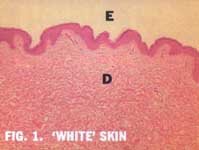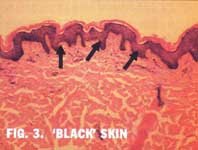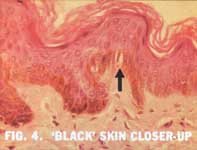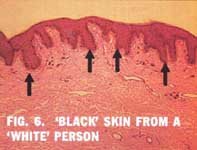Skin Deep
Originally published in Creation 18, no 3 (June 1996): 46-48.
Many people still think that 'light' skin is somehow tremendously different from 'dark' skin, in spite of the scientific evidence that shows overwhelming biological similarity among all people.
However, over the past four decades, sophisticated studies of human skin pigmentation using special stains and the electron microscope have shown that the differences in skin pigmentation among the so-called races of mankind are only very minor.
A world-renowned authority in clinical dermatology, Dr Anthony du Vivier at London's King's College Hospital, accurately sums up present scientific knowledge on the subject: 'There are the same number of melanocytes [pigment-forming cells] to be found in both Negroid and Caucasian skin.'1
Other experts agree; the differences in colouration arise from the way in which melanin (the dark pigment found in the skin of all people) is packaged. The melanosomes (tiny melanin-packaging units) are slightly larger and more numerous per cell in dark-skinned than light-skinned people. They also do not degrade as readily, and disperse into adjacent skin cells to a higher degree.2,3
This means that the differences are at a subcellular level; that is, there are minor variations in very minute areas, called organelles, residing in the pigment cells. These variations are under the control of the normal principles of genetics. Genetic information in people has been constructed by the Creator so as to allow a remarkable capacity to vary the pigmentation of the skin and hair.
Actually, skin and hair colour result from the relative levels of two types of melanin pigment: the dark-brown pigment discussed above, and a reddish version of the pigment. All people produce the red pigment, but red-headed people lack the ability to produce normal levels of the dark pigment. This is now thought to be due to a mutation in one of the genes involved in pigment manufacture in the skin cells.4
Not only do red-heads lack the ability to produce much protective dark pigment, but their red pigment reacts directly with sunlight to produce chemicals which cause damage to their DNA, which leads to skin cancer. Red-heads must therefore be doubly careful in their exposure to the sun. Red hair may be beautiful, but the condition almost certainly arose from a mutation causing the loss of ability to produce dark pigment. Eve was not a red-head!
GENES FOR ALL SKIN COLOURS
The family which survived the Flood would have to have had sufficient genetic variability to account for the full range of normal skin colours in their descendants — thus they would have likely had middle-brown skin. Such people would have had a mixture of genes which code for light and dark skin — giving them brown skin. When the genes for light skin came together in their children they would be lighter in colour than their parents; when genes for dark skin came together the children would be darker than their parents. The red-head condition almost certainly arose some time later.
It took an event like the confusion of languages and the resultant dispersion at Babel to break humanity into smaller separated groups. Because each group would have been much smaller than the entire population, each would therefore have had less ability to vary than the original population and so would have had a more consistent skin colour.
Social preferences could also have developed with discrimination against variant skin types for marriage, resulting in even more consistent skin colour developing. People living in tropical areas could have realized that light skin was detrimental to health (and ability to work in the sun) and so persons with light skin would come to be seen as undesirable candidates for marriage. Conversely, people living at high latitudes could have developed discrimination against dark skin because of its association with rickets in the low-light environments.
EVOLUTIONARY RACISM
For a long time, evolutionists held that the visible differences between groups of people arose through long time periods in which they were isolated from each other. This teaching has given rise to many racist ideas, as it implies that one group may have evolved more slowly than another, and thus be somehow less human. If true, it would also suggest that the differences were biologically substantial.
From the Bible's account of man's origins one would predict, on the other hand, that even the seemingly obvious differences between various groups would be biologically trivial, which is exactly what we find in all respects.
The accompanying series of photographs of skin taken through an ordinary light microscope should dispel the notion that there are any radical differences between 'black' and 'white' skin.

Fig. 1 is a low magnification view of skin from a 32-year-old with so-called Caucasoid, or 'white' skin. There is little visible pigment at the boundary between the dermis (D) and the epidermis (E).

Fig. 2 is a higher magnification view of the same sort of skin. Little pigment is visible in the epidermis, although several cells (arrowed) with a clear area (cytoplasm) around a darker central nucleus have the appearance of melanocytes (cells which produce pigment).

Fig. 3 is a low magnification view of skin from a young African. There is abundant pigmentation within numerous cells in the epidermis, especially at its boundary with the dermis (arrows).

Fig. 4 shows the same sort of darkly pigmented skin at the higher magnification. The arrow shows a cell which has the appearance of a melanocyte. There are innumerable granules of the pigment itself which, having been produced in one of the melanocytes, have diffused into other cells (keratinocytes), mostly those at the boundary.
Even within the same individual, skin colour may change. 'White' skin can undergo an increase in pigmentation. There is of course the normal tanning response to sunlight, which increases the production of melanin. Also, in some clinical conditions 'white' skin can become virtually indistinguishable from black skin. Equally, black skin can lose pigmentation to look the same as 'white' skin.

Fig. 5 looks at chronically inflamed skin from the leg of an African. On the right side (horizontal arrow) depigmentation is nearly complete. Toward the middle and left of the picture, spotty, irregular pigmentation persists (arrows). The skin colour varied in this same person from black to brown to nearly white.

Fig. 6 shows skin from a 'white' person, from a portion affected by a disease called lentigo simplex. Almost all the cells along the boundary (see arrows) are very deeply pigmented, much as in normal skin of an African, as shown in Fig. 3. There is also a condition of deficiency of function of the adrenal gland in which the entire skin of a Caucasian can become deeply pigmented. This would have the same sort of appearance under the microscope.
Since such simple fluctuations in pigment granules can change black skin to 'white' skin and vice versa, this again emphasizes the trivial nature of the differences.
In short, a close look at our skin is totally consistent with Paul's famous address at Mars Hill, in which he reminded his audience of the Genesis truth that God has 'made of one blood [i.e. from one man] all nations of men'.5 What a difference it would have made to the course of history, even in pre-Darwinian times, if people had taken the Creator's account of our origins seriously enough to realize that we are all very closely related.
REFERENCES
Anthony du Vivier, Atlas of Clinical Dermatology, Gower Medical Publishing Ltd, London, 1986, p. 23.2.
A. Bernard Ackerman, Histopathologic Diagnosis of Skin Diseases, Lea and Febiger, Philadelphia, 1978, p. 44.
Walter F. Lever, and G. Schaumberg-Lever, Histopathology of the Skin, 7th edition, J.B. Lippincott Co., Philadelphia, 1990, pp. 18-20.
Philip Cohen, 'Redheads come out of the shade', New Scientist, 30 September, 1995, p.18.
The Holy Bible, Acts 17:26 (KJV).
In many scientific circles, it is customary to refrain from ascribing 'purpose' to any biological feature. In the case of melanin (see main article), it is difficult to avoid appreciating its positive function. Du Vivier well states:
'In addition to skin and hair coloration, melanin pigment is of extreme importance for protection against the injurious properties of ultraviolet radiation.'1
The likely middle-brown colouration of Noah's family (and before them, Adam and Eve) would have afforded good protection against moderate sun exposure. In contrast, the pigment-depleted skin of Caucasoids is so vulnerable to sun damage that Lever said:
'No white person past 40 years of age has normal elastic tissue in the skin of the face.'3
Increased skin 'aging', and vulnerability to various types of skin cancer are among the disadvantages for whites due to their lesser amount of melanin. This pigment is only one of the marvellous protective mechanisms that an all-wise Creator built into the information that makes up humans.
Recommended Resources

Answers in Genesis is an apologetics ministry, dedicated to helping Christians defend their faith and proclaim the good news of Jesus Christ.
- Customer Service 800.778.3390
- Available Monday–Friday | 9 AM–5 PM ET
- © 2026 Answers in Genesis




